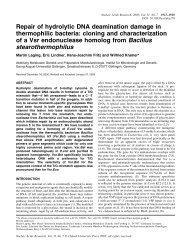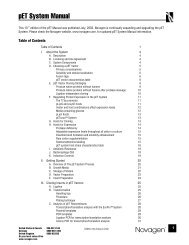DNA Mismatch Repair: Functions and Mechanisms
DNA Mismatch Repair: Functions and Mechanisms
DNA Mismatch Repair: Functions and Mechanisms
Create successful ePaper yourself
Turn your PDF publications into a flip-book with our unique Google optimized e-Paper software.
<strong>DNA</strong> <strong>Mismatch</strong> <strong>Repair</strong> Chemical Reviews, 2006, Vol. 106, No. 2 315<br />
4.6. Comments on the Models<br />
While the <strong>DNA</strong> bending model has several attractive<br />
features <strong>and</strong> has garnered significant experimental support,<br />
it has a major shortcoming. Analysis of the bacterial <strong>and</strong><br />
human mismatch repair systems has demonstrated that both<br />
respond to heteroduplex orientation: the excision reaction<br />
elicited at the str<strong>and</strong> break depends on its 3′ or 5′ placement<br />
relative to the mismatch. Function in this manner requires<br />
that the repair system establish heteroduplex orientation, <strong>and</strong><br />
it is not clear how this can be accomplished by a bending<br />
mechanism. Determination of the relative orientation of the<br />
two <strong>DNA</strong> sites would seemingly depend on the transduction<br />
of a signal along the helix contour.<br />
It is well established that MutS homologues are capable<br />
of ATP-dependent movement along the helix, <strong>and</strong> several<br />
studies have attributed a similar mobility to MutS‚MutL<br />
homologue complexes, although our underst<strong>and</strong>ing of this<br />
assembly is at an early stage. ATP-dependent movement in<br />
this manner could in principle serve to establish heteroduplex<br />
orientation, <strong>and</strong> this idea has received much attention in the<br />
literature. However, there is no proof that that this type of<br />
mechanism is responsible for signaling between the two <strong>DNA</strong><br />
sites involved in mismatch repair.<br />
A third model that could serve to establish heteroduplex<br />
orientation has received less attention in the literature. In<br />
this type of mechanism, mismatch recognition by a MutS<br />
homologue serves as a nucleation site for polymerization of<br />
a second protein along the helix. 235 In fact, yeast MutLR<br />
has been shown to cooperatively polymerize on <strong>DNA</strong> in a<br />
manner that dramatically increases with chain length. 236<br />
Although polymerization is readily evident at modest MutLR<br />
concentrations, it is largely abolished at physiological salt<br />
concentrations in the presence of Mg 2+ . Furthermore, electron<br />
microscopic visualization of bacterial MutS <strong>and</strong> MutL on<br />
heteroduplex <strong>DNA</strong> under repair conditions has failed to<br />
reveal evidence for significant polymerization. 231 Nevertheless,<br />
it may be premature to discount this type of model,<br />
because a treadmilling variation has not been excluded. For<br />
example, a mechanism in which addition of a MutL (or<br />
MutS) unit to the head of polymer chain occurs only slightly<br />
faster than dissociation from the tail would yield a polymer<br />
of only modest length. Such a mechanism would not only<br />
suffice to establish heteroduplex orientation but also confer<br />
apparent movement along the helix, as has been described<br />
in a number of the studies described above.<br />
5. <strong>Mismatch</strong> <strong>Repair</strong> in the <strong>DNA</strong> Damage<br />
Response<br />
5.1. Lesions that Trigger a <strong>Mismatch</strong><br />
<strong>Repair</strong>-Dependent Damage Response<br />
The mammalian mismatch repair system has been implicated<br />
in the cellular response to several types of <strong>DNA</strong><br />
damage, including lesions produced by S N 1 <strong>DNA</strong> methylators,<br />
6-thioguanine, 5-fluoro-deoxyuridine, cisplatin, ultraviolet<br />
light, <strong>and</strong> several carcinogens. Recognition <strong>and</strong> perhaps<br />
processing of such lesions by mismatch repair leads to<br />
activation of damage signaling pathways, resulting in cell<br />
cycle arrest <strong>and</strong>, at high lesion load, apoptosis. The versatility<br />
of the repair system in terms of its ability to respond to a<br />
variety of base pair anomalies, including conventional<br />
mismatches, has led to the suggestion that it may function<br />
as a general sensor of <strong>DNA</strong> damage. 14,292<br />
The cytotoxic effects of S N 1 <strong>DNA</strong> methylators (e.g.,<br />
N-methyl N-nitrosourea (MNU), N-methyl N′-nitro N-nitrosoguanidine<br />
(MNNG), temozolomide (8-carbamoyl-3-<br />
methylimidazo[5,1-d]-1,2,3,5-tetrazin-4(3H)-one), procarbazine<br />
(N-isopropyl-R-(2-methylhydrazino)-p-toluamide), <strong>and</strong><br />
dacarbazine (5-(3,3-dimethyl-1-triazenyl)-1H-imidazole-4-<br />
carboxamide) are largely due to production of O 6 -methylguanine,<br />
293-296 which can pair with cytosine or thymine. 297,298<br />
Although 6-thioguanine (6TG) has several modes of<br />
action, 299-302 the purine analogue is incorporated into <strong>DNA</strong><br />
where it is subject to spontaneous methylation by S-<br />
adenosylmethionine, with the resulting 6-MeTG presumed<br />
to pair with cytosine or thymine. 303 5-Fluoro-2′-deoxyuridine<br />
(FdU) can also be incorporated into <strong>DNA</strong> where it may also<br />
promote mispairing. 304,305<br />
Despite their intrinsic mutagenic activity, the cytotoxic<br />
effects of <strong>DNA</strong> methylators, 6-TG, FdU, <strong>and</strong> cisplatin have<br />
been exploited in their use as antitumor drugs. 294,295,304,306,307<br />
The effectiveness of these agents is often mitigated by<br />
development of resistance, a phenomenon that has been<br />
linked to defects in mismatch repair. Association of mismatch<br />
repair defects <strong>and</strong> drug resistance has been documented in<br />
cultured cells 14,15,151,300,308-312 <strong>and</strong> mice, 313 <strong>and</strong> clinical data<br />
are beginning to appear indicating that patients with mismatch<br />
repair-deficient cancers respond poorly to treatment<br />
with at least some of these agents. 314-316<br />
Involvement of mismatch repair in the cytotoxicity of<br />
<strong>DNA</strong> methylators <strong>and</strong> cisplatin was initially described in E.<br />
coli. Although wild-type E. coli are resistant to these<br />
compounds, strains deficient in the Dam methylase are<br />
sensitive to killing by these agents, <strong>and</strong> this sensitivity is<br />
reversed by introduction of mutS or mutL mutations. 13,317,318<br />
Thus, <strong>DNA</strong> methylator <strong>and</strong> cisplatin killing occur in a MutS<strong>and</strong><br />
MutL-dependent manner, but only when <strong>DNA</strong> lacks the<br />
GATC modification that directs repair. This killing effect<br />
has been attributed to production of double-str<strong>and</strong> breaks 77<br />
via cleavage of both str<strong>and</strong>s of an unmethylated GATC site<br />
by activated MutH. 93,319 The pathways leading to cell death<br />
in mammalian cells differ from those in E. coli, but as<br />
discussed below, a common theme in the two systems is the<br />
dependence on lesion recognition by a MutS homolog.<br />
The human lymphoblastoid cell line MT1 was isolated<br />
from TK6 cells by one-step selection for high-level resistance<br />
to the cytotoxic effects of MNNG <strong>and</strong> exhibits a<br />
mutator phenotype. 320 This cell line is defective in str<strong>and</strong>specific<br />
mismatch repair due to genetic inactivation of<br />
both MSH6 alleles <strong>and</strong> consequent MutSR deficiency. 14,130,132<br />
A similar correlation between methylation tolerance <strong>and</strong><br />
inactivation of MutSR was observed in cultured hamster<br />
cells 15 <strong>and</strong> mouse MSH2 -/- ES cells. 308 Subsequent studies<br />
have shown that MutLR is also required for the cytotoxic<br />
response elicited by <strong>DNA</strong> methylators <strong>and</strong> that MutSR <strong>and</strong><br />
MutLR defects also confer resistance to 6-TG, cisplatin, <strong>and</strong><br />
FdU. 151,154,300,305,309-311,321,322 It is noteworthy that MutSβ is<br />
not required for the response to <strong>DNA</strong> methylator damage.<br />
130,323,324<br />
The mismatch repair system has also been implicated in<br />
the cellular response to lesions produced by several chemical<br />
carcinogens, as well as those produced by ultraviolet<br />
irradiation. Deficiency of MutSR or MutLR renders human<br />
cells resistant to apoptotic killing by N-acetoxy-2-acetyl-2-<br />
aminofluorene (AAAF) <strong>and</strong> benzo[a]pyrene-7,8-dihydrodiol-<br />
9,10-epoxide (B[a]PDE). 325 AAAF derivatizes the C-8 of<br />
deoxyguanosine, whereas B[a]PDE attacks the exocyclic




